These honey fermented cranberries are a healthy, colorful, and delicious fermented recipe that is perfect for your Thanksgiving or holiday dinner. Fermented honey cranberries are made from nourishing real food ingredients, and are a wonderful recipe for gut health.
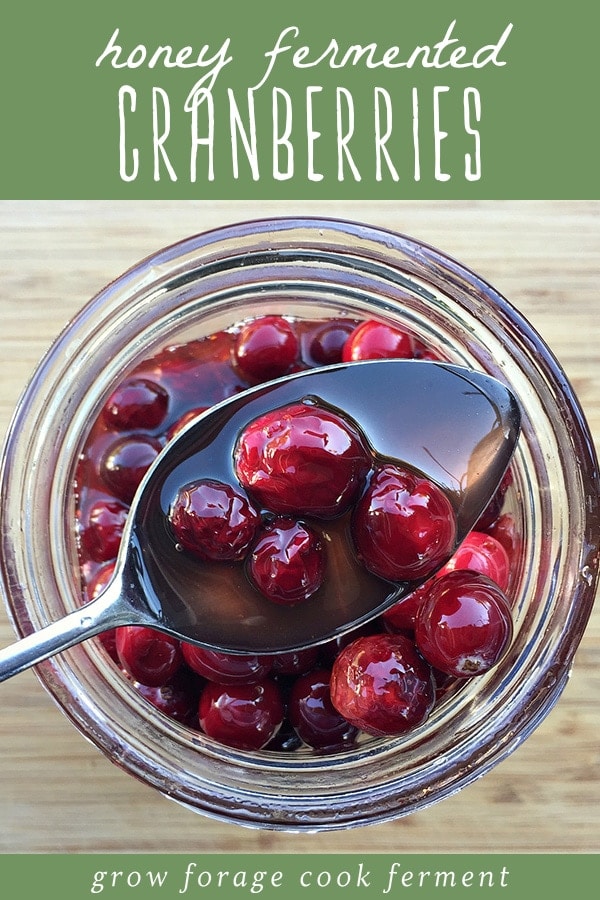
Want to save this post for later?
Fermenting Cranberries in Honey
It’s amazing to me how easy fermenting in honey is!
I’ve done all kinds of fermenting, and even have a recipe for fermented cranberries in a traditional brine. But for some reason, it took me a long time to ferment in honey. Well, I can tell you now that has changed and it’s one of my favorite cranberry recipes to make each year.
Here are more fermented honey recipes to try!
When I started my fermented honey garlic a while back, it got me thinking about what else I could ferment in honey.
I have seen recipes for berries in honey, and being that we’re coming up on the holiday season, fermenting cranberries in honey seemed like the natural thing to do.
I’m so glad I did because these fermented honey cranberries are awesome! This is probably how I will make my cranberries every year from now on.
Related: Canning Cranberry Sauce, Simple Spiced Cranberry Sauce, Quick Pickled Cranberries, Cranberry Champagne Cocktail
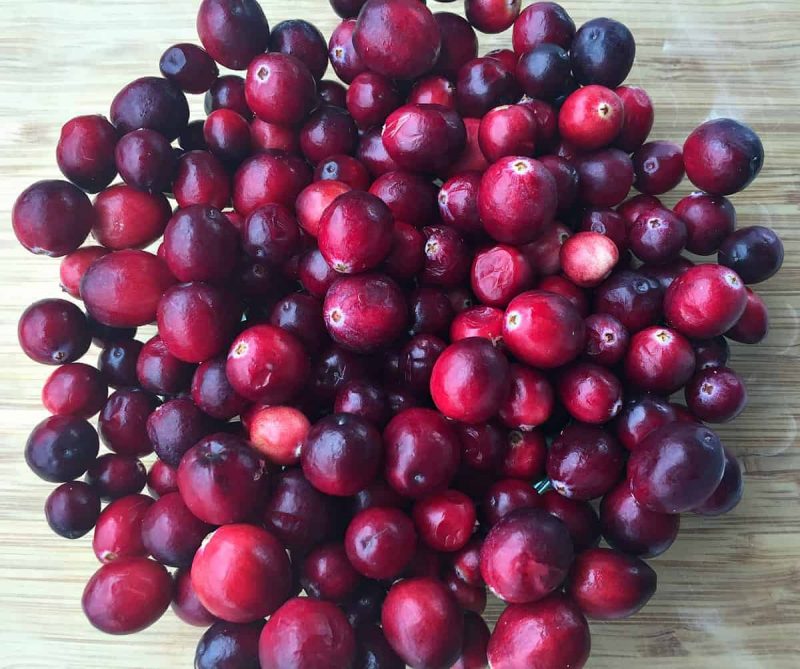
Get recipes for desserts, snacks, breads, side dishes, drinks, and preserving using apples, pumpkins, winter squash, cranberries, and more in my ebook, Cozy Autumn Recipes!
Fermented Honey Cranberries Recipe
Making these fermented honey cranberries is so easy that it hardly even needs a recipe!
The amounts are variable based on how much you want to make. I used a quart sized jar, and that seemed like a good amount to start with.
Prepare the Cranberries
The first step is to give the raw cranberries a little pop to break their skins and release some juices. Cranberries are tough to penetrate, so this will give the fermentation a bit of a head start.
I did this by poking them with a fork all over, but you could also give them a couple of pulses in a food processor.
Frozen cranberries can be used instead of fresh, but it is best to thaw them before adding the honey.
Add the Honey
Fill the jar with the cranberries, ginger slices, and cinnamon stick, leaving about an inch or so of head space.
Add in the orange juice (and the zest if you’d like as well), then cover the cranberries with raw honey.
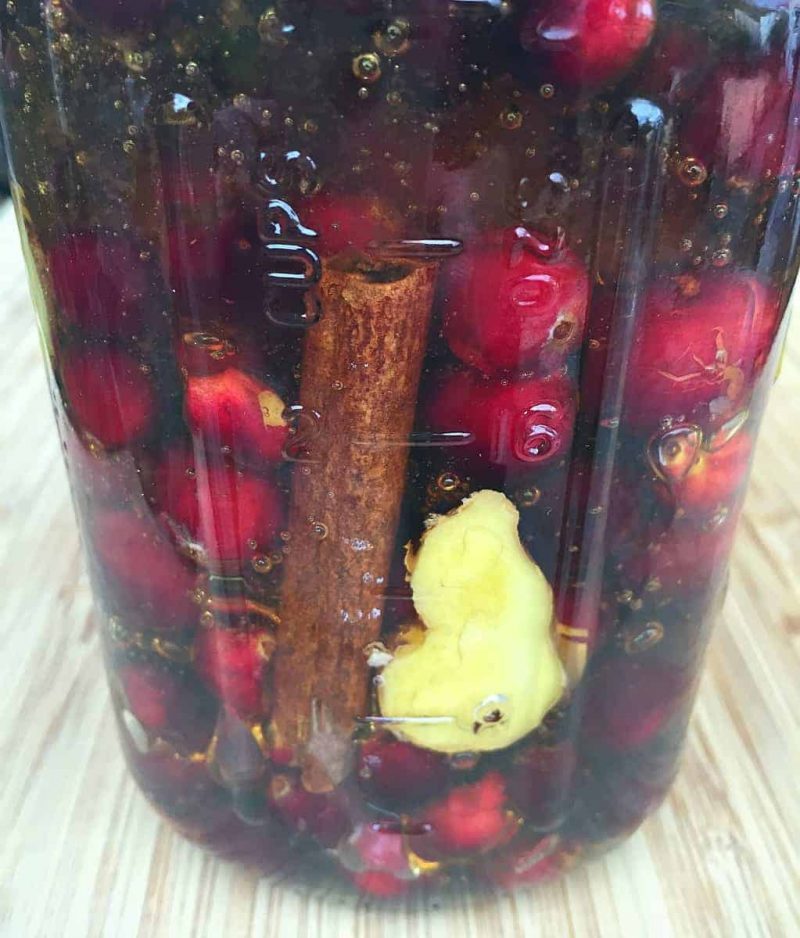
It may take a while for the honey to make its way all down to the bottom of the jar, so you may need to wait a bit for it to settle, then add some more.
The cranberries will want to float to the top, but that’s ok.
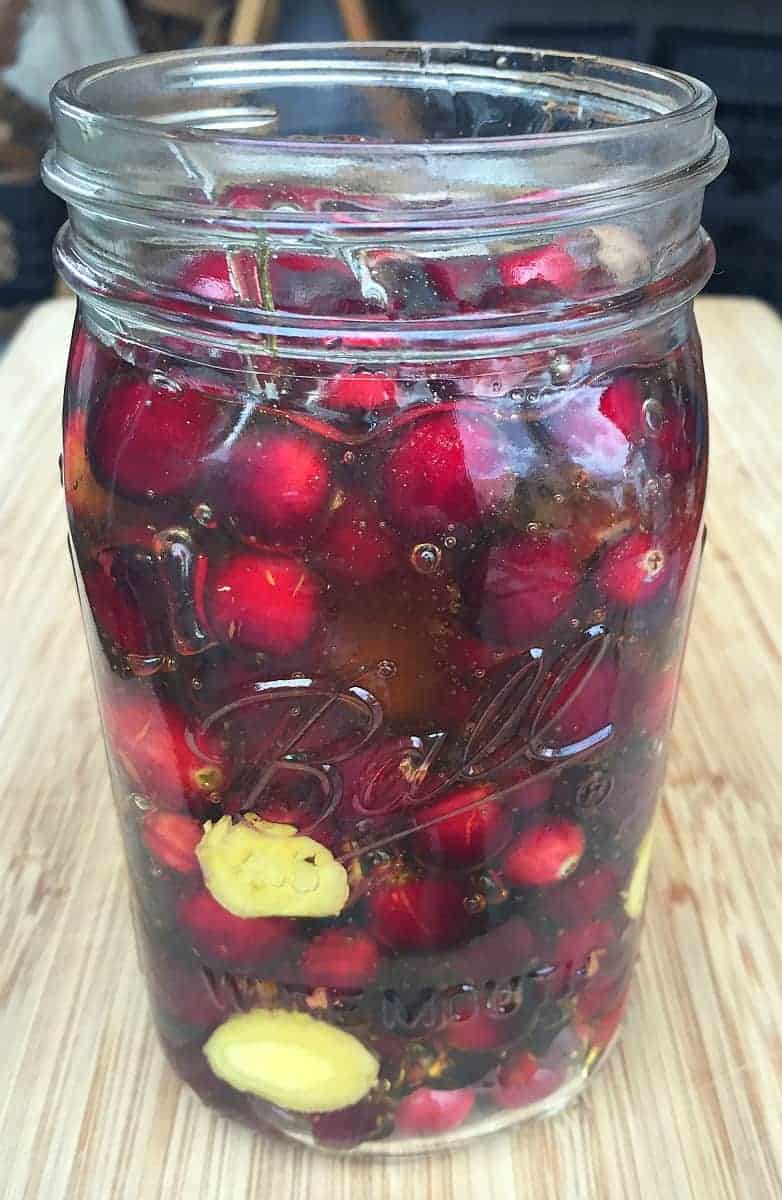
Cover and Flip
Cover the jar tightly and give it a few turns to coat all of the cranberries in honey.
If you are using a metal canning lid, I recommend putting a piece of parchment paper in between the lid and and jar, as the metal can sometimes react with the fermentation process.
Then loosen the lid and put the jar in a dark corner somewhere. It would be wise to put it on a plate in case there is any honey overflow as it ferments, which is likely.
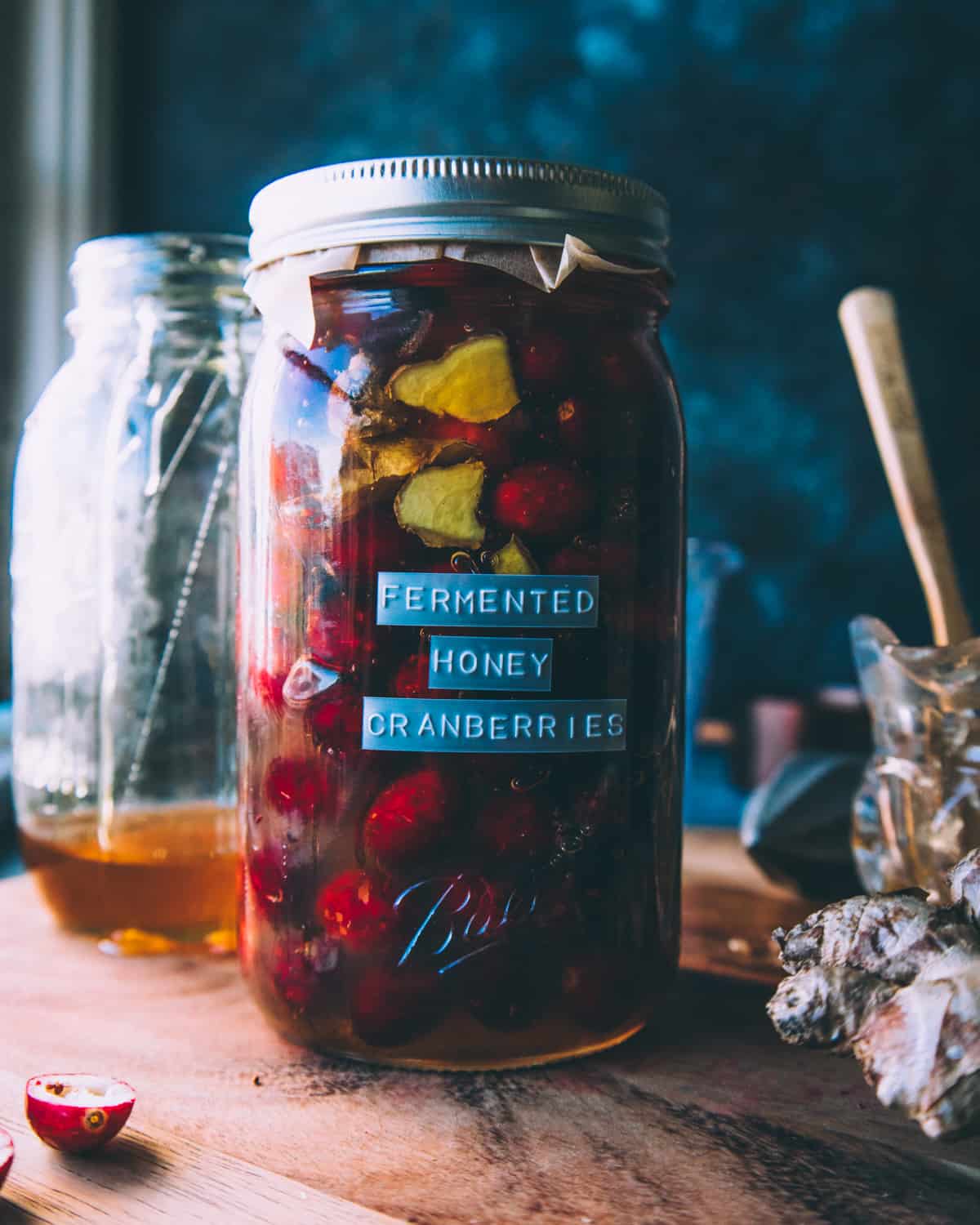
Every day or so tighten the lid and give the jar a few turns to coat the cranberries in honey again, then re-loosen the lid.
Within a few days to a week you will start to see bubbles forming in the jar! Sometimes the bubbles are very small or unnoticeable, but they usually do show up at some point.
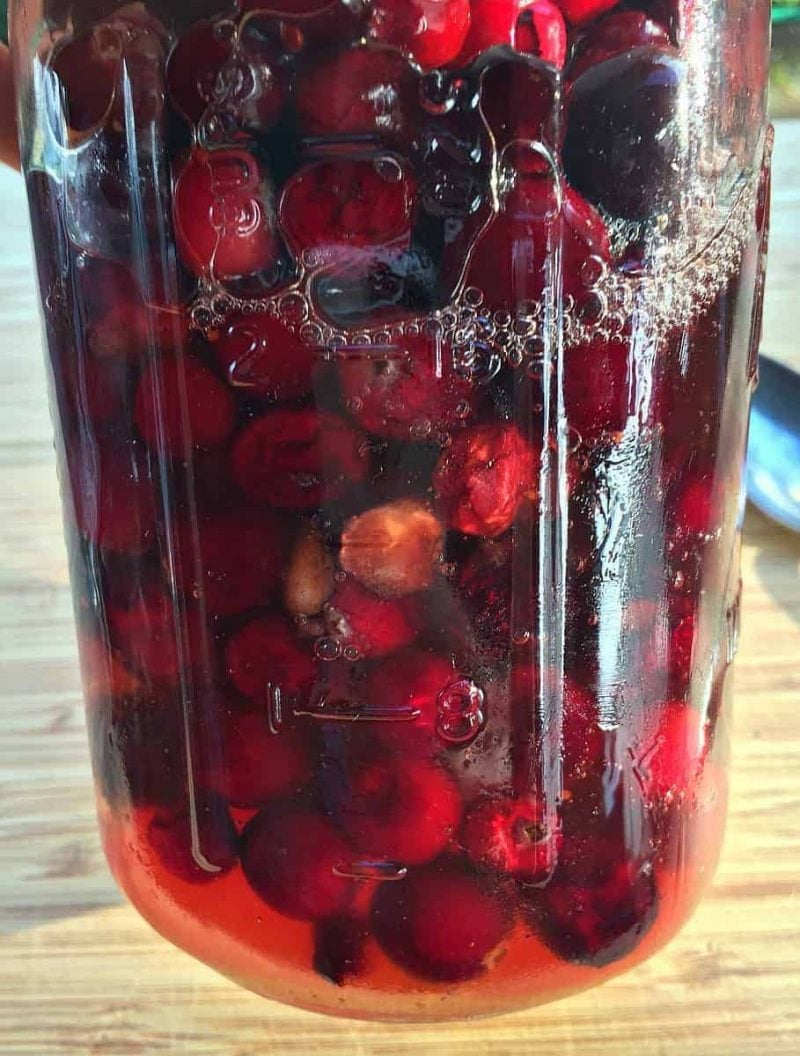
The honey will turn a lovely red color and will become runnier as time goes on. The cranberries will start to lose some of their tartness and will become a bit more wrinkled.
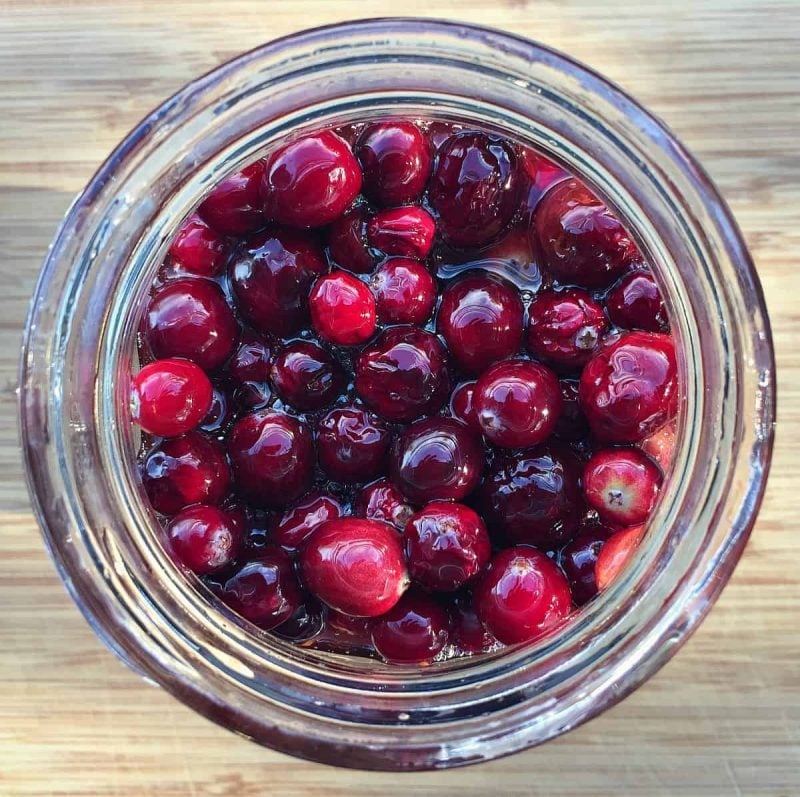
These can be left to ferment for quite a while, several months even, and will be tastier as time goes on. I think the flavor even after just a few weeks was amazing!
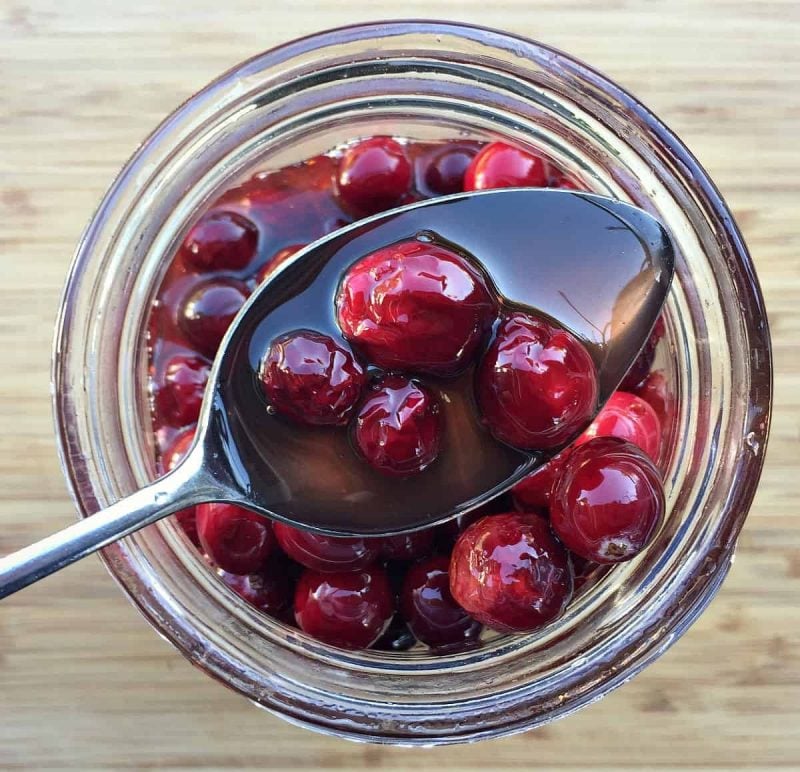
Using Fermented Honey Cranberries
You can serve and eat these delicious fermented honey cranberries as is, or you can try putting them in a food processor to grind them up into more of a cranberry sauce.
I think I’m going to try that on Thanksgiving this year. It’s never a bad idea to get some fermented food in during a big meal!
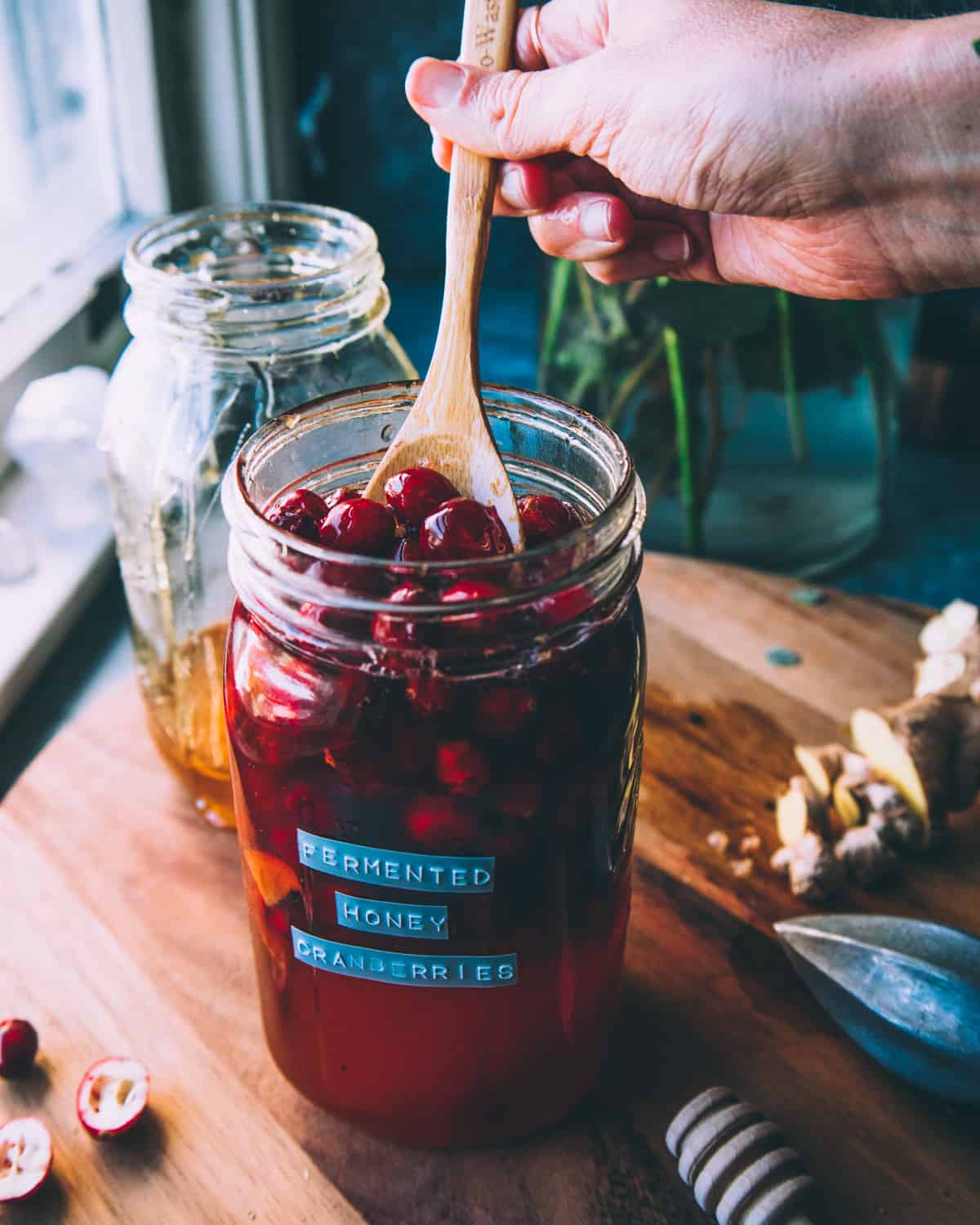
If you are concerned about botulism, which is very rare in this type of ferment, use a pH test strip. Botulism spores can’t reproduce with a pH of less than 4.6. Honey is usually around 3.9, but that can vary between brands. Cranberries are also highly acidic.
If the pH is too high, add a splash of raw apple cider vinegar to add more acidity and retest. This is generally not needed, but I do want to mention it to ease any worries.
Honey cranberries should not be given to babies under one year of age.
Low on time and want an amazing, nonfermented, cranberry sauce recipe? This spiced cranberry sauce with orange and ginger is my favorite!
Have you ever fermented cranberries? What did you think of the result?
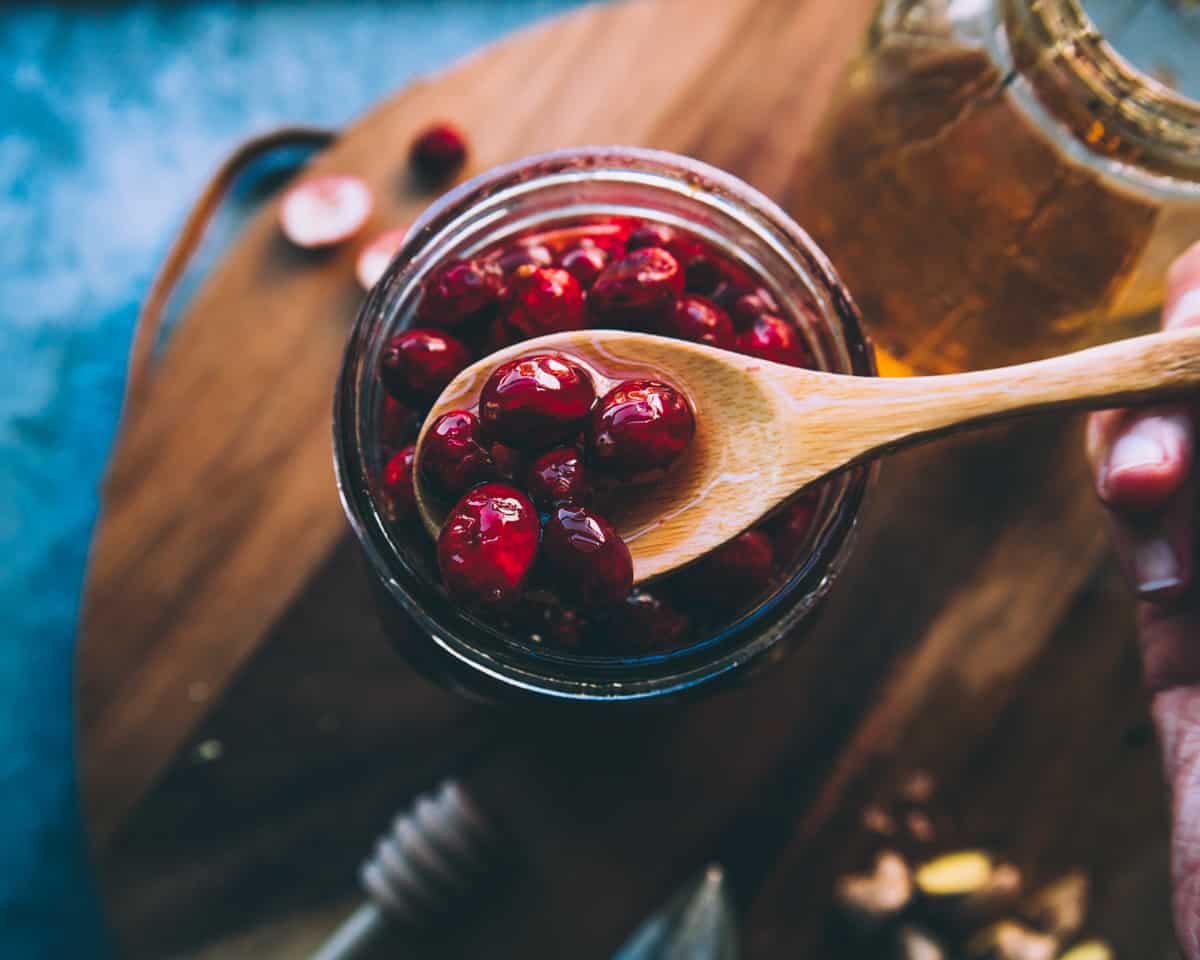
More Fermented and Infused Honey Recipes
Enjoy these other honey ferments and infusions!
- Fermented Elderberry Honey
- Herbal Infused Honey
- Fermented Honey Garlic
- Lilac Flower Infused Honey
- Fermented Ginger Honey
- Fermented Jalapeno Honey
- Fermented Honey Blueberries
Fermented Honey Cranberries
Equipment
Ingredients
- 3 cups fresh cranberries skins slightly crushed
- 1″ knob ginger sliced
- 1 cinnamon stick
- 1 orange juiced
- 2 cups raw honey or enough to completely cover the cranberries
Instructions
- Break the skins of the cranberries to release some of their juices by either piercing the skins with the tines of a fork, or gently pulsing in a food processor.
- Place the bruised cranberries into a quart-sized mason jar. Add the ginger slices, cinnamon stick and orange juice and stir. Then pour in enough raw honey to cover the cranberries.
- Place the lid securely on the jar, then give it a few turns to coat all of the cranberries in the honey.
- Loosen the lid, then place the jar into a dark place to ferment. Every few days, tighten the lid, give the jar a few turns, then re-loosen the lid.
- Within a few days to a week you will begin to see small bubbles forming in the honey.
- The honey cranberries will ferment for a month or more, but you can eat them at any time. The honey will turn a red color, and will become more runny as time goes on. The cranberries will start to lose some of their tartness, and will become a bit more wrinkled.
- Store in a cool place for many months or even a year or more.
Notes
- It’s important to use raw honey for this recipe, as it has all of the bacteria and wild yeast that is necessary for fermentation.
- The small amount of orange juice will create just enough liquid for fermentation to happen.
- It’s a good idea to put a plate underneath the jar during fermentation, as it will likely bubble up and a little bit of honey could possibly drip out.
- If you are concerned about botulism, use a pH test strip. Botulism spores can’t reproduce with a pH of less than 4.6. Honey is usually around 3.9, but that can vary between brands. Cranberries are also highly acidic.
- If the pH is too high, add a splash of raw apple cider vinegar to add more acidity and retest. This is generally not needed, but I do want to mention it.
- Honey cranberries should not be given to babies under one year of age.

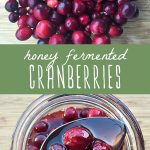
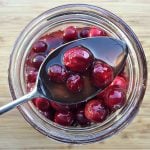

These are wonderful!! Blew right through the first 2 quarts. New batch going now.
Yay! I’m so happy you like them!
Hi,
I have made this recipe twice and its been both successful and delicious both times. I pulsed some up in a blender and put it in a couple jars to send for Christmas. Are there any concerns of someone getting sick? It produced a lot of honey juice, but I strained off most of it. It tastes delicious, but having blended/crushed the berries will it remain shelf stable? Does it need to be refrigerated at all? Thanks for your input.
No, it doesn’t need to be refrigerated. Honey doesn’t spoil. While there’s a tiny chance of botulism, it’s extremely rare and highly unlikely. If you’re concerned, adding a splash of apple cider vinegar will regulate the pH.
Hello!
Do these cranberries perform well in pies and tortes, or do you find that the fermentation messes with baking?
Thanks!
You’ll definitely lose the good bacteria that you cultivated with fermentation in the baking process, but I’m sure it’ll still taste really good!
Hello, Colleen..gonna try your recipe :) Question: Just found a 2 yr old cranberry ferment that I did in 1/19…absolutely no mold, smelled great..got brave enough to taste..tart, nice vinegary flavor, no off taste at all….safe to use in something? Your suggestions please..thanks, Maggie
As long as it smells good and there’s no mold, it’s safe. If you’re concerned, add a splash of apple cider vinegar to regulate the pH.
Hello! I didn’t have the perfect-sized jar for this, so I have a few inches of air space between the cranberries and the lid. Will that harm the fermentation process? I tried to make sure the cranberries were covered in honey but they are all floating at the top with inches of liquid below them. Thanks for any advice or input!
That’s perfectly fine! Just be sure to flip the jar upside down every day to resubmerge the floaters.
Hi there! If you have a cranberry lover that is allergic to citrus what would you suggest to swap for orange juice? Could apple or pineapple work?
Sure! This recipe is super flexible. You could also try using apple cider (or another vinegar flavor) as an alternative.
Looks intriguing! Can I use another citrus, such as lime juice or Meyer lemon juice?
I am allergic to oranges (& to some lemons.)
Thank you!
Of course! I hope you enjoy it!
PS I punctured each cranberry once with a toothpick and it worked perfectly!
Awesome, I’m so glad, Debbie!
Thanksgiving day & we’ve just consumed the honey-fermented frozen cranberries. As directed, I thawed the cranberries, added honey, put in a piece of star anise & flipped the jar 2-3 times a day for the first couple of weeks and then stuck it in a closed shed outside (colder) for the last month. The cranberries were left whole and the best my husband and I’ve ever had! Thank you for this brilliant idea. Next: cherries and another batch for Christmas and NEXT year!
Hi – I would like to split this recipe into 2 separate smaller jars to give out as gifts. Would that change the fermenting time?
Hi Tess! Nope, the fermentation time should still be the same.
How do you know when these are ready to eat? Thanksgiving is 3 weeks away. If I start them now, will they be ready for Thanksgiving? Your notes say you can eat them anytime – does that mean any time after they are done fermenting? Anytime after they start fermenting? Anytime, even if they don’t ferment?
They can ferment up to a month or more. In a few days, bubbles will form and they’ll begin fermenting. You can eat them at any point along the way, even if they don’t ferment.
I like your recipe w the ginger,cinnamon and orange. I have fermented in honey berries,garlic, and hot peppers like jalapeños. I’ve not added spices. I’m going to try your additions. These types of ferments are really delicious to baste chicken, pork or roasted vegetables with as well. Thank you
Thanks, Deb! That sounds like a wonderful way to baste a chicken. I think I’ll try that!
Does it require being turned every so often or at some point can the lid be left tightly closed, and set aside?
This is my first try at fermenting. My berries seem to want to float and honey is clearly at the bottom of the jar, all berries are coated though. Is this okay? Thanks so much!
That’s fine. You’ll just need to flip it every day or two to resubmerge the floating berries.
Thank you. Should I get weights or use something to keep pressure on it so it stays imursed? Is there a beginner kit anyone would recommend?
Thank you.
What are your thoughts on blending the honey and cranberries after fermentation…sort of like sauce?
That sounds like a delicious idea!
I worried that I should have blended the cranberries into a sauce as well, but I ended up keeping them whole and it was AMAZING. They pop in your mouth and burst open with a delicious mix of tart/sweetness. I’m leaving my cranberries whole when I honey-ferment now and forever! Just amazing! PS Try adding a piece of Star Anise. The result is exquisite!
That is excellent! I’m so happy you loved the fermented cranberries. Adding star anise is a wonderful idea. I may have to try that in my next batch. Thanks for sharing!
Hi,
I made this recipe in the past, but was wondering if I can preserve it for family for Thanksgiving and Christmas. Does it require refrigeration?
Yes, you can. Honey is a natural preservative and as you ferment the cranberries, they become preserved as well. Honey does not require refrigeration and can be stored in your pantry for many months.
Does it require being turned every so often or at some point can the lid be left tightly closed, and set aside?
Yes, you’ll want to turn it over every few days or so to resubmerge the cranberries. After about a month of fermenting, you can tightly close the lid.
Can I use frozen cranberries?
Yes, Joanne, you can use frozen cranberries for this. Just make sure to let them thaw for at least an hour beforehand and you should have enough good bacteria to get the fermentation started in your raw honey!
Is the orange necessary for the fermentation, ie acid, or is it just for flavor? Not a big fan of orange and cranberry.
Hi Jocelyn, it’s just for flavor, so feel free to omit it.
I started mine a few months ago and it took almost a month, but it finally did have a good few weeks of bubbling and fermenting. That has since slowed to none and I am wondering what to do once the ferment is done? Store at room temp with a lid? In the fridge? Thanks for your thoughts!
Hello!
I followed this recipe and it’s been over a month but there is no activity happening, no bubbling nor is the honey really even getting thinner like your instructions say it should. It is in a dark spot and room temp averages between 70-75 degrees. Should my ingredients have all been organic for it to work? I’m not sure what I did wrong :(
Did you use store-bought honey? The recipe specifies RAW honey. I only see bubbles when I rotate the jar every three days.
Yes, I’ve used store-bought raw honey. Regular honey will not ferment because it’s pasteurized. Pasteurization kills the good bacteria needed for the fermentation process to begin.
I have made this in the past. This year I don’t have much honey but I have an abundance of Maple syrup. Could I use that instead of honey?
Hi Stephanie, you could try it, but I’m thinking it might not work because maple syrup doesn’t have the same wild yeasts and good bacteria as honey. I’ve never tried it though, so I can’t say for sure!
I started my cranberries fermenting in local raw honey about 4 weeks ago. There have been no bubbles (except when I shake it up) and there’s a milky white cloud in the bottom of the jar. This looks similar to the goo that shows up in the bottom of fruit juices kept in the fridge too long. Is this safe to eat? It doesn’t smell like alcohol, just smells sweet. Help!
Hi Pat, the bubbles don’t always happen, or are sometimes too small to notice. It may or may not have fermented much (hard for me to say for sure without seeing it myself), but it is still safe to eat as honey is a natural preservative.
My cranberries have been fermenting for about 10 days now, but have not produced any bubbles. I fear I may have used pasteurized honey instead of raw. How should I proceed? Add water? Yeast? Patience??
Hi Alex, bubbles don’t always happen, or are too small to see. I wouldn’t add any water or yeast, just be patient :) You may have used pasteurized honey, which would just mean that not much fermenting happened, but it will still be delicious and safe to eat.
2.5 is very acidic. 4.5 may be okay, but anything above 4.5 or 4.6 is not acidic enough to prevent botulism, although I think botulism in this type of ferment would be rare!
Two months so far, and NO BUBBLES! Why isn’t it working?
Hi Krystal, bubbles don’t always appear, or they are often too small to see. Regardless, your cranberry honey will still be delicious and safe to eat!
I’ve had my batch in the closet for 4 months with no change either. Even after adding a little water, I think it’s so acidic it’s shelf stable. Not what I was hoping for, but it’s still delicious! I’m planning on eating the sweet cranberries and using the honey mixture for a batch of mead.
I started my cranberry’s 3 weeks ago, there’s a few bubbles but not many. Also instead of using a fork to break the skin I used a grater on the small sharp side used to grate nutmeg and cinnamon, I just rolled them around on it with the palm of my hand.
Hey Everyone,
I followed the directions and made a honey/cranberry ferment. I’m in Los Angeles where the temps have been ranging from 90s to 60s over the past month. After chopping the cranberries and putting them in some Kirkland, local raw honey, they didn’t seem to be producing any bubbles for the first couple weeks. Finally in week 3 they started producing a lot of bubbles. I ph tested the honey and it seems to be hovering around 2.5, which isn’t acidic enough to prevent botulism. Is there any botulism concern with this recipe? Is it strange that they’ve been fermenting for a month and a half now and the acidity is at 2.5? Any tips would be appreciated, I’m a bit nervous about tasting it. I made a honey/garlic ferment where the acidity went above 4.5 and it was great.
You are forgetting about sugar’s role in preservation. Botulism can’t survive in that concentration of sugar, sugar is extremely hydrophilic, and desicates any bacterium, that’s why honey doesn’t spoil.
What do you mean by the acidity is at 2.5? Are you talking about pH? If so that is very acidic and most microbes won’t grow in that. Remember with pH, the lower the number, the more acidic.
I started these in October to have for Thanksgiving and they are great. This process is very easy and my first foray into fermentation. I am hoping to save some for Christmas as well! Can some of the liquid that is left be used to “jump start” another batch?
I have a jar of cranberries and a jar of pomegranates fermenting right now. The pomegranates seem to have come to a good fizz after about three weeks, the cranberries a barely fizzing. So to give them a jumpstart I added a bit of the pomegranate honey and NOW they are starting!
I have the same concern as Susan — I am on day 18 and it looks lovely — but is beginning to smell a bit alcohol-ish? What are the chances? IF so, any guess what the content would be?
Hi Linda, anything that is fermented will have a small amount of alcohol. I have some fermented honey cranberries that are over a year old and they taste very slightly of alcohol, but it’s not much!
I set this up to ferment, and put a tiny jar, on top, to keep the berries under the surface. It seems to be going well. Beautiful, and bubbly. HOWEVER. I have a concern. Am I making ALCOHOL? Is this turning into MEAD? UH OH.
Hi Susan, anything that is fermented will produce a small amount of alcohol. The amount of alcohol that these honey fermented cranberries make is very small! You would need more water for it to be mead :)